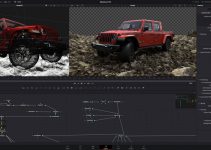Have you ever wanted to attach text to the ground in your aerial shots (or any other type of shot) in a few easy steps? Unbeknownst to a lot of folks, achieving this effect is not complicated to pull off, nor does it require any high level of knowledge and expertise in digital compositing and VFX.
Instead, the effect can all be done inside of Adobe After Effects CC without any additional tools or other third-party plugins. All you’ll need is a little bit of time, effort, as well as this handy tutorial created by Josh from Olufemii Tutorials that showcases exactly how to attach text to the ground turning it into the perfect addition to your next drone shot, especially if your project calls for it.
Inside of After Effects, create a new composition and add your footage to the timeline. If you don’t see the Tracker panel on the side of the platform, click on Window in the upper menu and then select Tracker. Once you’ve located the Tracker panel, open it and click on Track Camera. After Effects will then begin tracking your footage and eventually create tracking points. While the footage is tracking in the background, you can continue to make any other edits to whatever clips you may have in the composition.
If the tracking has completed successfully, you will see that After Effects has created a multitude of markers in your footage. Mouseover your image and you’ll notice a red target as you hover over it. These are called planes. To properly attach text to the ground, first, you need to find a plane that is flat against the ground. Then you should right-click on the area and select Create Text and Camera.
In the timeline of your composition, you will see that After Effects has added a Camera and Text layer. Using the text tool, select the text layer and edit it as desired, adjusting the content, modifying the font, size, or even color. You can also tweak parameters such as the scale, rotation, and position. As you play back your footage, you will see that your text is perfectly attached to the ground while following the movement of the camera.
Lastly, if you’ve positioned your text to be standing tall as showcased in the video, one way you can elevate the realism of the effect is by adding a shadow. To do so, duplicate the text layer and rotate the X-axis forward or backward (depending on where the source of light is located) so that it is perpendicular to the original text layer. Position the duplicate text in front or behind the original one. Finally, change the text color to black and adjust the opacity so that it appears as a shadow in your image.
Overall, this basic compositing technique will allow you to attach virtually any other object to your footage regardless of its dimension and size as long as it complements your composition and enhances the visual concept you are trying to accomplish.
[source: Olufemii Tutorials]
Disclaimer: As an Amazon Associate partner and participant in B&H and other affiliate programmes, we earn a small comission from each purchase made through the affiliate links listed above at no additional cost to you.



Useful, thanks!
That’s a very useful technique. I’ve used that on many productions. If you want to add some more realism set the layer blending mode of the shadow to “color burn” and extrude the text so it get’s some depth in 3D. On a side note: the sun is coming from behind, look at the long shadows from the cars on the street to the left 😉 …in this particular example I’d place the shadow to the front. Other thank that, well done.